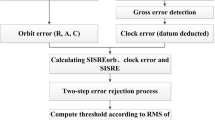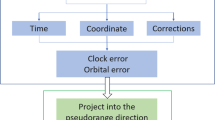Abstract
The integrity of Global Navigation Satellite System (GNSS) has the capability of sending a timely alarm to users when the GNSS is out of use, and it is one of the significant parameters of GNSS. Compared with ground-based integrity monitoring, integrity monitoring within the satellite constellation itself could lessen the effects of possible failures in the signal propagation path and ground systems and shorten the alarm time, which would quickly alert users of the system failure. Developing satellite autonomous integrity monitoring (SAIM) has been one of the main objectives of the upgrade plan for future GNSS such as GPS III, Galileo and the third generation of Beidou satellite navigation system (BDS3). To test the new technology, BDS3 experimental satellites are equipped with SAIM payload which is independently developed by China and it is the first satellite navigation system that applies SAIM method to monitor the navigation signals integrity. SAIM monitors signal quality and clock and frequency stability. We briefly introduce the payload design of SAIM on BDS3 experimental satellites, and evaluate in detail the monitoring measurements stability for two new civil signals of BDS3 open service, B1C_pilot signal, and B2a_pilot signal. By artificially setting signal faults, we analyze the time-to-alert performance of SAIM under its two kinds of alarming modes. The results show that the onboard observation stabilities of signal power, pseudorange, code carrier bias, and code carrier divergence are better than 0.12 dB, 0.1 ns, 0.14 ns, and 3.5 mm/s, respectively, which were reliable at 1-year interval. The onboard satellite clock step monitoring precision is approximately 0.5 ns. Once the abnormal signal is detected, the BDS SAIM may provide a warning within 6 s. With the characteristics of overcoming the ground monitoring network limitation and fast alarming ability, SAIM is expected to be an effective method to enhance the BDS3 system integrity monitoring capability.









Similar content being viewed by others
References
Cao Y, Hu X, Zhou J, Wu B, Liu L, Zhou S, Su R, Chang Z, Wu X (2014) Kinematic wide area differential corrections for BeiDou regional system basing on two-way time synchronization. Lect Notes Electr Eng 305(3):277–288
China Satellite Navigation Office (2017a) BeiDou navigation satellite system signal in space interface control document. Open Service Signal B1C (Version 1.0)
China Satellite Navigation Office (2017b) BeiDou navigation satellite system signal in space interface control document. Open Service Signal B2a (Version 1.0)
Fernandez F (2011) Inter-satellite ranging and inter-satellite communication links for enhancing GNSS satellite broadcast navigation data. Adv Space Res 47(5):786–801
Hewitson S, Wang J (2006) GNSS receiver autonomous integrity monitoring (RAIM) performance analysis. GPS Solut 10(3):155–170
ICAO (2006) Annex 10 to the convention on international civil aviation, volume I
Kovach K, Dobyne J, Crews M, Miles C (2008) GPS III integrity concept. In: Proceedings of ION GNSS 2008, Institute of Navigation, Savannah, GA, USA, September 16–19, 2250–2257
Liu L, Zhu L, Han C, Liu X, Li C (2009) The model of radio two-way time comparison between satellite and station and experimental analysis. Chin Astron Astrophys 33(4):431–439
Liu W, Hao J, Lv Z, Xie H, Tian Y (2013) A method of integrity monitoring and assessment for BeiDou navigation satellite system. Lect Notes Electr Eng 244:211–219
Montenbruck O, Hauschild A, Steigenberger P, Hugentobler U, Teunissen P, Nakamura S (2013) Initial assessment of the COMPASS/BeiDou-2 regional navigation satellite system. GPS Solut 17(2):211–222. https://doi.org/10.1007/s10291-012-0272-x
Oehler V, Luongo F, Trautenberg H, Boyero J, Krueger Jan, Rang T (2004) The Galileo Integrity Concept and Performance. In: Proceedings of ION GNSS 2004, Long Beach, CA, USA, September 21–24, 604–615
Parkinson BW, Axelrad P (1988) Autonomous GPS integrity monitoring using the pseudorange residual. Navigation 35(2):255–274
Peckjian A, Shaw S, Katronick AJ (2016) Maturation of GPS III signal integrity improvements, September 12–16. ION GNSS + 2016, Institute of Navigation, Portland, pp 2910–2921
Rodriguez I, Garcia C, Catalan C, Mozo A, Tavella P, Galleani L, Rochat P, Wang Q, Amarillo F (2009) Satellite autonomous integrity monitoring (SAIM) for GNSS systems. In: Proceedings of ION GNSS 2009, Institute of Navigation, Savannah, GA, USA, September 22–25, 1330–1342
Rodriguez I, Garcia C, Catalan C, Mozo A, Tavella P, Galleani L, Amarillo F (2011) Inter-satellite links for satellite autonomous integrity monitoring. Adv Space Res 47(2):197–212
Seynat C, Flament D, Brocard D (2009) EGNOS status update. In: Proceedings of ION GNSS 2009, Institute of Navigation, Savannah, Georgia, USA, September 22–25, 3457–3483
Vioarsson L, Pullen S, Green G, Enge P (2001) Satellite autonomous integrity monitoring and its role in enhancing GPS user performance. In: Proceedings of ION GPS 2001, Institute of Navigation, Salt Lake, UT, USA, September 11–14, 690–702
Wolf R (2000) Onboard autonomous integrity monitoring using intersatellite links. In: Proceedings of ION GPS 2000, Institute of Navigation, Salt Lake, UT, USA, September 19–22, 1572–1581
Wu Z, Zhou S, Hu X, Liu L, Shuai T, Xie Y, Tang C, Pan J, Zhu L, Chang Z (2018) Performance of the BDS3 experimental satellite passive hydrogen maser. GPS Solut 22(2):43. https://doi.org/10.1007/s10291-018-0706-1
Xiao W, Liu W, Sun G (2016) Modernization milestone: BeiDou M2-s initial signal analysis. GPS Solut 20(1):125–133
Xu H, Wang J, Zhan X (2011) GNSS satellite autonomous integrity monitoring (SAIM) using inter-satellite measurements. Adv Space Res 47(7):1116–1126
Zhou S, Hu X, Wu B, Liu L, Qu W, Guo R, He F, Cao Y, Wu X, Zhu L et al (2011) Orbit determination and time synchronization for a GEO/IGSO satellite navigation constellation with regional tracking network. Sci China Phys Mech Astron 54:1089–1097
Zhou S, Cao Y, Zhou J, Hu X, Tang C, Liu L, Guo R, He F, Chen J, Wu B (2012) Positioning accuracy assessment for the 4GEO/5IGSO/2MEO constellation of COMPASS. Sci China Phys Mech Astron 55:2290–2299. https://doi.org/10.1007/s11433-012-4942-z
Acknowledgements
The authors are grateful for the comments and remarks of the reviewers, which helped to improve the manuscript. This work was supported by the National Key Research Program of China as the “Collaborative Precision Positioning Project” (No. 2016YFB0501900), National Natural Science Foundation of China (Grant Nos. 41674041 and 11203059) and the Shanghai Key Laboratory of Space Navigation and Position Techniques (Grant No. 12DZ2273300).
Author information
Authors and Affiliations
Corresponding author
Additional information
Publisher’s Note
Springer Nature remains neutral with regard to jurisdictional claims in published maps and institutional affiliations.
Rights and permissions
About this article
Cite this article
Cao, Y., Hu, X., Chen, J. et al. Initial analysis of the BDS satellite autonomous integrity monitoring capability. GPS Solut 23, 35 (2019). https://doi.org/10.1007/s10291-019-0829-z
Received:
Accepted:
Published:
DOI: https://doi.org/10.1007/s10291-019-0829-z




